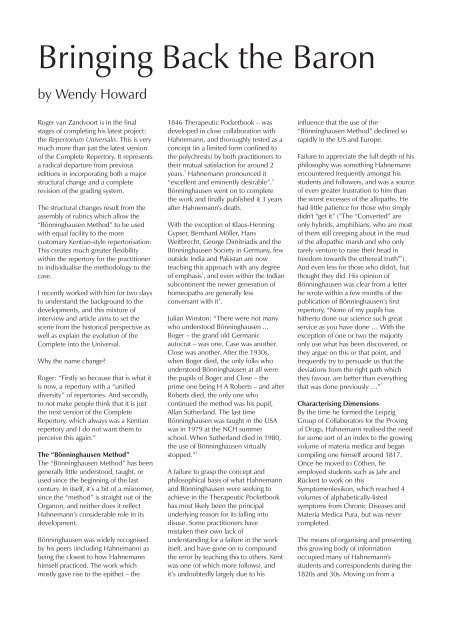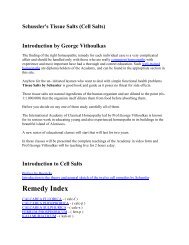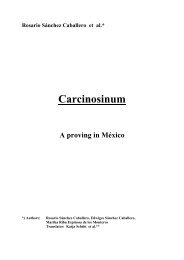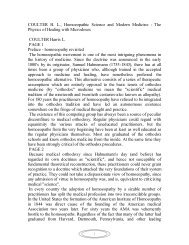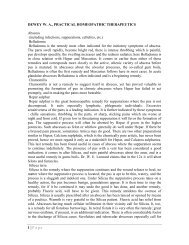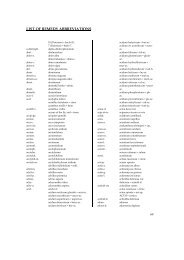B.nninghausen Article.cdr - Hpathy
B.nninghausen Article.cdr - Hpathy
B.nninghausen Article.cdr - Hpathy
Create successful ePaper yourself
Turn your PDF publications into a flip-book with our unique Google optimized e-Paper software.
Bringing Back the Baron<br />
by Wendy Howard<br />
Roger van Zandvoort is in the final<br />
stages of completing his latest project:<br />
the Repertorium Universalis. This is very<br />
much more than just the latest version<br />
of the Complete Repertory. It represents<br />
a radical departure from previous<br />
editions in incorporating both a major<br />
structural change and a complete<br />
revision of the grading system.<br />
The structural changes result from the<br />
assembly of rubrics which allow the<br />
“Bö<strong>nninghausen</strong> Method” to be used<br />
with equal facility to the more<br />
customary Kentian-style repertorisation.<br />
This creates much greater flexibility<br />
within the repertory for the practitioner<br />
to individualise the methodology to the<br />
case.<br />
I recently worked with him for two days<br />
to understand the background to the<br />
developments, and this mixture of<br />
interview and article aims to set the<br />
scene from the historical perspective as<br />
well as explain the evolution of the<br />
Complete into the Universal.<br />
Why the name change?<br />
Roger: “Firstly so because that is what it<br />
is now, a repertory with a “unified<br />
diversity” of repertories. And secondly,<br />
to not make people think that it is just<br />
the next version of the Complete<br />
Repertory, which always was a Kentian<br />
repertory and I do not want them to<br />
perceive this again.”<br />
The “Bö<strong>nninghausen</strong> Method”<br />
The “Bö<strong>nninghausen</strong> Method” has been<br />
generally little understood, taught, or<br />
used since the beginning of the last<br />
century. In itself, it’s a bit of a misnomer,<br />
since the “method” is straight out of the<br />
Organon, and neither does it reflect<br />
Hahnemann’s considerable role in its<br />
development.<br />
Bö<strong>nninghausen</strong> was widely recognised<br />
by his peers (including Hahnemann) as<br />
being the closest to how Hahnemann<br />
himself practiced. The work which<br />
mostly gave rise to the epithet – the<br />
1846 Therapeutic Pocketbook – was<br />
developed in close collaboration with<br />
Hahnemann, and thoroughly tested as a<br />
concept (in a limited form confined to<br />
the polychrests) by both practitioners to<br />
their mutual satisfaction for around 2<br />
1<br />
years. Hahnemann pronounced it<br />
2<br />
“excellent and eminently desirable”.<br />
Bö<strong>nninghausen</strong> went on to complete<br />
the work and finally published it 3 years<br />
after Hahnemann's death.<br />
With the exception of Klaus-Henning<br />
Gypser, Bernhard Möller, Hans<br />
Weitbrecht, George Dimitriadis and the<br />
Bö<strong>nninghausen</strong> Society in Germany, few<br />
outside India and Pakistan are now<br />
teaching this approach with any degree<br />
3<br />
of emphasis , and even within the Indian<br />
subcontinent the newer generation of<br />
homeopaths are generally less<br />
4<br />
conversant with it .<br />
Julian Winston: “There were not many<br />
who understood Bö<strong>nninghausen</strong> ...<br />
Boger – the grand old Germanic<br />
autocrat – was one. Case was another.<br />
Close was another. After the 1930s,<br />
when Boger died, the only folks who<br />
understood Bö<strong>nninghausen</strong> at all were<br />
the pupils of Boger and Close – the<br />
prime one being H A Roberts – and after<br />
Roberts died, the only one who<br />
continued the method was his pupil,<br />
Allan Sutherland. The last time<br />
Bö<strong>nninghausen</strong> was taught in the USA<br />
was in 1979 at the NCH summer<br />
school. When Sutherland died in 1980,<br />
the use of Bö<strong>nninghausen</strong> virtually<br />
5<br />
stopped.”<br />
A failure to grasp the concept and<br />
philosophical basis of what Hahnemann<br />
and Bö<strong>nninghausen</strong> were seeking to<br />
achieve in the Therapeutic Pocketbook<br />
has most likely been the principal<br />
underlying reason for its falling into<br />
disuse. Some practitioners have<br />
mistaken their own lack of<br />
understanding for a failure in the work<br />
itself, and have gone on to compound<br />
the error by teaching this to others. Kent<br />
was one (of which more follows), and<br />
it’s undoubtedly largely due to his<br />
influence that the use of the<br />
“Bö<strong>nninghausen</strong> Method” declined so<br />
rapidly in the US and Europe.<br />
Failure to appreciate the full depth of his<br />
philosophy was something Hahnemann<br />
encountered frequently amongst his<br />
students and followers, and was a source<br />
of even greater frustration to him than<br />
the worst excesses of the allopaths. He<br />
had little patience for those who simply<br />
didn't “get it” (”The “Converted” are<br />
only hybrids, amphibians, who are most<br />
of them still creeping about in the mud<br />
of the allopathic marsh and who only<br />
rarely venture to raise their head in<br />
6<br />
freedom towards the ethereal truth” ).<br />
And even less for those who didn't, but<br />
thought they did. His opinion of<br />
Bö<strong>nninghausen</strong> was clear from a letter<br />
he wrote within a few months of the<br />
publication of Bö<strong>nninghausen</strong>’s first<br />
repertory, “None of my pupils has<br />
hitherto done our science such great<br />
service as you have done … With the<br />
exception of one or two the majority<br />
only use what has been discovered, or<br />
they argue on this or that point, and<br />
frequently try to persuade us that the<br />
deviations from the right path which<br />
they favour, are better than everything<br />
7<br />
that was done previously …”<br />
Characterising Dimensions<br />
By the time he formed the Leipzig<br />
Group of Collaborators for the Proving<br />
of Drugs, Hahnemann realised the need<br />
for some sort of an index to the growing<br />
volume of materia medica and began<br />
compiling one himself around 1817.<br />
Once he moved to Cöthen, he<br />
employed students such as Jahr and<br />
Rückert to work on this<br />
Symptomenlexikon, which reached 4<br />
volumes of alphabetically-listed<br />
symptoms from Chronic Diseases and<br />
Materia Medica Pura, but was never<br />
completed.<br />
The means of organising and presenting<br />
this growing body of information<br />
occupied many of Hahnemann's<br />
students and correspondents during the<br />
1820s and 30s. Moving on from a
simple alphabetical listing of symptoms,<br />
various categorisations were proposed<br />
based on the principal characterising<br />
dimensions of symptoms (stipulated in<br />
8<br />
the Organon ), and several<br />
(Bö<strong>nninghausen</strong>, Jahr, Hering, Gross,<br />
Rückert, among others) applied<br />
themselves to how that might be<br />
translated into various forms of<br />
9<br />
reference in their own individual ways.<br />
The principal characterising dimensions<br />
which Bö<strong>nninghausen</strong> used to structure<br />
his repertories, and used to greatest<br />
effect in the Therapeutic Pocketbook,<br />
were according to location, sensation,<br />
modalities and accessory symptoms (or<br />
concomitants). These four dimensions,<br />
particularly the last, have to a large<br />
extent become synonymous with the<br />
“Bö<strong>nninghausen</strong> Method”, largely due<br />
to H A Roberts who repeatedly asserted<br />
in the introductions he wrote to later<br />
10<br />
editions of Bö<strong>nninghausen</strong>'s work that<br />
it was Bö<strong>nninghausen</strong> who evolved the<br />
“doctrine of concomitants”. But this was<br />
11<br />
simply taken directly from the Organon<br />
and was by no means uniquely<br />
Bö<strong>nninghausen</strong>'s thinking. Hering<br />
published an article in Stapf's Archiv in<br />
1832 in which he proposed an identical<br />
schema. 12<br />
Symptom Combinations<br />
The feature which mostly distinguishes<br />
the “Bö<strong>nninghausen</strong> Method” from<br />
other applications of Hahnemann's<br />
principles is the idea of recombining the<br />
component parts of symptoms in order<br />
to reflect the totality of the patient.<br />
As Stuart Close remarked: “The Totality<br />
is an ideal not always to be realised. As a<br />
matter of fact, in practical experience, it<br />
is often impossible to complete every<br />
symptom, or even a large part of the<br />
symptoms. Patients have not observed,<br />
or cannot state all these points. They will<br />
give fragments; the location of a<br />
sensation which they cannot describe,<br />
or a sensation which they cannot locate;<br />
or they will give a sensation, properly<br />
located, but without being able, through<br />
ignorance, stupidity, failure to observe or<br />
forgetfulness, to state the conditions of<br />
time and circumstances under which it<br />
appeared. Sometimes no amount of<br />
questioning will succeed in bringing out<br />
the missing elements of some of the<br />
13<br />
symptoms.”<br />
While working on amalgamating and<br />
updating his earlier repertories, which<br />
had also been developed in close<br />
Clemens Maria Franz von Bö<strong>nninghausen</strong> (1785-1864) came to<br />
homeopathy relatively late in life after being cured of tuberculosis at the<br />
14<br />
age of 43. According to Gross, the remedy was Pulsatilla. His family<br />
were one of the oldest of the nobility of Rhineland and Westphalia,<br />
though of relatively moderate means. He initially trained as a lawyer and<br />
was invited to join the Dutch State service at the court of Louis<br />
Napoléon, King of Holland, where his talents were recognised in a<br />
succession of rapid promotions until the king's abdication in 1810. From<br />
the age of 25, he devoted himself to agriculture and had a reputation for<br />
his extensive botanical knowledge, though he returned to State service as<br />
the President of the Provincial Court of Justice for Westphalia in 1816<br />
and became General Commissioner for the land-register of the Rhineland<br />
15<br />
and Westphalia in 1822. Following his cure from tuberculosis in 1828,<br />
he threw himself into the study of homeopathy and became a regular<br />
correspondent of Hahnemann's, an energetic prover, and gathered<br />
considerable fame as a practitioner, all while continuing to travel<br />
extensively in the service of the State. At the age of 58 he was granted<br />
authority to practice medicine (without a medical examination) by order<br />
of the Cabinet of King Friedrich Wilhelm IV, and retired from State<br />
service immediately to devote himself entirely to homeopathy, which he<br />
practiced for a further 21 years. He had an enormous practice. It's<br />
estimated from his 112 bulky quarto volumes of case records that he saw<br />
16<br />
3-4 times the number of patients seen by Hahnemann himself.<br />
Bö<strong>nninghausen</strong> had the distinction of publishing the first repertory, the<br />
Repertory of the Antipsoric Remedies, with a preface by Hahnemann, in<br />
1832. It sold out very quickly, prompting a second edition in 1833 which<br />
was retitled Systematic Alphabetical Repertory of Homeopathic<br />
Remedies, First Part, again with an introduction – or, more accurately, a<br />
treatise on olfaction – by Hahnemann. This was followed by the<br />
Repertory of Medicines which are not Antipsoric (or Systematic<br />
Alphabetical Repertory of Homeopathic Remedies, Second Part) in 1835.<br />
The Therapeutic Pocketbook for Homeopathic Physicians for use at the<br />
Bedside and the Study of Materia Medica Pura was published in 1846.<br />
Hahnemann wrote about him “…if I should be ill myself and unable to<br />
17<br />
help myself I would not entrust myself to any other physician.” His<br />
contempories described him as “…one of the first master minds of<br />
18<br />
homeopathic science.”
consultation with Hahnemann,<br />
Bö<strong>nninghausen</strong> was constantly<br />
confronted with three major problems:<br />
the material was becoming too<br />
large and unwieldy to be of much<br />
practical use,<br />
in breaking up symptoms into their<br />
component parts in order to index<br />
them, the comprehension of the<br />
totality was being lost, and<br />
many gaps were apparent in the<br />
symptom pictures of the remedies<br />
due to the incomplete nature of the<br />
proving symptoms<br />
(Bö<strong>nninghausen</strong>’s comparisons<br />
between proving records and his<br />
own case records convinced him<br />
that provers’ powers of observation<br />
were essentially no better than<br />
those of patients).<br />
The solution grew out of his ongoing<br />
discussions with Hahnemann and a<br />
thorough and continual analysis of his<br />
own case records. These were<br />
painstakingly collected, with every<br />
symptom itemised exactingly as per the<br />
19<br />
instructions in the Organon and<br />
arranged into two columns according to<br />
whether they were common or<br />
20<br />
individual. According to Roberts, “He<br />
soon learned that symptoms which<br />
existed in an incomplete state in some<br />
part of a given case could be reliably<br />
completed by analogy, by observing the<br />
conditions of other parts of the case. If,<br />
for instance, it was not possible by<br />
questioning a patient to decide what<br />
aggravated or ameliorated a particular<br />
symptom of the case, the patient would<br />
readily express a condition of<br />
amelioration of some other symptom. It<br />
did not take long to discover that<br />
conditions of aggravation or<br />
amelioration are not confined to this or<br />
that particular symptom; but that, like<br />
the red thread in the cordage of the<br />
British Navy, they apply to all the<br />
21<br />
symptoms of the case.”<br />
Bö<strong>nninghausen</strong> relates the development<br />
of his thinking in his introduction:<br />
“Fearing to divide symptoms more than<br />
has been done hitherto, and which has<br />
been deprecated many times, it was my<br />
first intention to retain the form and<br />
arrangement of my original repertory,<br />
which Hahnemann repeatedly assured<br />
me he preferred to all others, and to<br />
condense it into one volume, making it<br />
clearer in every part, as well as more<br />
complete from analogy as well as from<br />
experience. But, after finishing about<br />
half of the manuscript, I found it had<br />
increased on my hands beyond all<br />
expectation to such a size that, at last, I<br />
gave it up, as I saw it was extremely<br />
probable that a similar object might be<br />
attained in a more simple and<br />
satisfactory manner, if, by bringing out<br />
the peculiarities and characteristics of<br />
the remedies according to their various<br />
relations, I opened a way into the wide<br />
fields of combinations which hitherto<br />
22<br />
had not been trodden.”<br />
The work has been criticised for deemphasising<br />
mental symptoms, bearing<br />
in mind §211, but this was quite<br />
deliberate. Bö<strong>nninghausen</strong> was well<br />
aware of the potential for such<br />
symptoms to be misconstrued or<br />
misinterpreted, particularly by beginners<br />
– “I have therefore deemed it advisable<br />
to give here only the most essential and<br />
predominant points under as few rubrics<br />
as possible, in order to make it more<br />
easy to find them out.” 23<br />
He also added a further section – the<br />
concordances – which listed extensive<br />
and clinically verified remedy<br />
relationships.<br />
Bö<strong>nninghausen</strong>’s Rise …<br />
The Therapeutic Pocketbook was<br />
published in German with simultaneous<br />
translations in French (by<br />
Bö<strong>nninghausen</strong> himself) and English (by<br />
Stapf). An “improved” French edition<br />
was published by Roth, but was done so<br />
carelessly that lists of remedies were<br />
24<br />
placed under the wrong rubrics. Stapf's<br />
translation was full of mistakes and 17<br />
25<br />
rubrics were omitted altogether. Shortly<br />
after, three English language bootleg<br />
editions appeared: by Okie and Hempel<br />
in the US, and Laurie in the UK. The<br />
Okie and Hempel editions duplicated<br />
Stapf’s errors, while the Laurie edition<br />
was translated from Roth’s French<br />
26<br />
version. The Hempel edition appears<br />
to have been the one most widely used,<br />
and though his translations were<br />
27<br />
criticised, his work in this instance is<br />
regarded as the more accurate of the<br />
28<br />
early editions. The Okie edition<br />
omitted the Concordances because<br />
29<br />
Okie didn’t understand them. T F<br />
Allen’s later attempt at updating the<br />
work has been criticised for its<br />
rearrangement of the headings, faulty<br />
translations, omission of 4 remedies,<br />
failure to reintroduce the missing 17<br />
rubrics, and the fact that additions for<br />
30<br />
220 new remedies were unsourced.<br />
Despite all these errors, an indication of<br />
the repertory’s perceived value comes<br />
through in an anecdote told about E E<br />
Case, known for his repertory work, by<br />
one of his students (T G Sloan). “Dr<br />
Case was not brilliant, but was a<br />
tremendously hard worker, the most<br />
industrious man I ever knew. Years ago<br />
he copied long-hand Bö<strong>nninghausen</strong>’s<br />
Pocketbook, from cover to cover, as it<br />
was out of print and he could not get a<br />
31<br />
copy.”<br />
… and Fall …<br />
The completion of symptoms by analogy<br />
has not been without its critics – notably<br />
Hering and Kent. Hering was an<br />
advocate of preserving proving<br />
symptoms in their entirety, since it was<br />
the complete symptom that had been<br />
demonstrated as characteristic of the<br />
remedy. His opinion was that splitting<br />
and recombining symptoms would lead<br />
to too wide a field of seemingly similar<br />
remedies without means of<br />
32<br />
differentiation. However, Hering had<br />
perhaps failed to appreciate the extent<br />
to which §153 informed<br />
Bö<strong>nninghausen</strong>’s work. Those symptoms<br />
which he fragmented in order that they<br />
could be recombined were chosen only<br />
after careful research through the<br />
provings and his case records. They<br />
were chosen because their component<br />
dimensions were each in some way<br />
characteristic of the remedy. Because of<br />
the paucity of proving data,<br />
Bö<strong>nninghausen</strong> had structured the<br />
repertory to be inclusive rather than<br />
exclusive: that is, to yield the widest<br />
possible selection of remedies close to<br />
being characteristic of the case, between<br />
which the practitioner could then<br />
differentiate by reference to the materia<br />
medica (”There is no doubt that a<br />
diligent and comprehensive study of the<br />
pure Materia Medica cannot be<br />
thoroughly accomplished by the use of<br />
any repertory whatever. I have not<br />
intended to dispense with such a study,<br />
but rather have considered all works of<br />
33<br />
such intent positively injurious.” ).<br />
Kent was full of praise for the<br />
Therapeutic Pocketbook in the early<br />
years of his practice and used it to<br />
illustrate many of his early cures. His<br />
disenchantment with it only seemed to<br />
begin after he became progressively<br />
more immersed in Swedenborg’s ideas<br />
following his move to Philadelphia. (His<br />
second wife, Clara, who he married only<br />
9 months after his first wife Lucia’s
34<br />
death , was a leading figure in the<br />
Swedenborgian Church of<br />
35<br />
Philadelphia . ) His statement that “All<br />
my teaching is founded on that of<br />
Hahnemann and of Swedenborg; their<br />
36<br />
teachings correspond perfectly.” (my<br />
emphasis) shows to what extent he<br />
came to conflate the two disciplines<br />
and, as a result, appeared no longer<br />
capable of perceiving where they parted<br />
company. He believed himself to be<br />
totally in tune with Hahnemann, but his<br />
very inability to understand<br />
Bö<strong>nninghausen</strong> clearly shows the extent<br />
to which he was mistaken.<br />
Kent’s hierarchy of symptoms owes<br />
more to Swedenborg than it does to<br />
Hahnemann. Swedenborg’s philosophy<br />
was hierarchical; his doctrine of Discrete<br />
Degrees held “that man’s mind is<br />
created in ranks or platforms one above<br />
37<br />
another.” This conceptualisation,<br />
reflected in Kent’s stratification of the<br />
mental symptoms, does not fit the view<br />
of the totality as a singularity, a unity, a<br />
complete picture comprising all “… the<br />
deviations from the former healthy state<br />
of the now diseased individual, which<br />
are felt by the patient himself, remarked<br />
by those around him and observed by<br />
38<br />
the physician” which was the basic<br />
concept underlying Hahnemann and<br />
Bö<strong>nninghausen</strong>’s approach.<br />
By the time Kent produced his own<br />
repertory, his criticisms of<br />
Bö<strong>nninghausen</strong> had become more<br />
frequent and vociferous (prompting<br />
some to suggest that Kent had less<br />
honourable motives at heart), but<br />
throughout the records of his opinions<br />
on the subject it seems not so much<br />
Bö<strong>nninghausen</strong>’s Therapeutic<br />
Pocketbook he’s criticising, but his own<br />
faulty understanding of it – even though<br />
it’s clear Kent believed fervently that it<br />
was the former rather than the latter that<br />
was at fault.<br />
39<br />
A few examples from 1911 : “He<br />
[Hahnemann] never recommended<br />
concomitants of a part affected.<br />
Concomitants cannot come into<br />
consideration except as in connection<br />
with an objective condition. Study the<br />
patient and everything of the patient. If<br />
you do not grasp this you do not receive<br />
Hahnemann's idea of treating the<br />
patient. I would urge you to shun<br />
concomitants as it leads away from the<br />
idea emphasised by Hahnemann.<br />
[…]<br />
“With the thoughts centred on a thing in<br />
one part of the body, then on the<br />
concomitants and then on the<br />
modalities, as recommended in the<br />
preface of Bö<strong>nninghausen</strong> and in<br />
Boger’s methods, you are led far away<br />
from the trend of Hahnemann, and<br />
homeopathy is destroyed by such<br />
methods. If that method were<br />
successful, I would not oppose it; but it<br />
is not in line with Hahnemann's<br />
methods. It does not lead to the<br />
characteristic symptoms of the case.<br />
[…]<br />
“By the Bö<strong>nninghausen</strong> method, there is<br />
no opportunity to distinguish between<br />
the patient and the particulars. This<br />
method has retarded the development<br />
of homeopathy. It has obscured<br />
Hahnemann's homeopathy.”<br />
As Julian Winston has pointed out, “That<br />
need [to distinguish between the patient<br />
and the particulars] is peculiar to Kent’s<br />
thought process. He cannot understand<br />
how someone can see in a way other<br />
than his. Kent had on very large<br />
blinders. There were many things he<br />
was blind about. We should keep that in<br />
40<br />
mind.”<br />
Notwithstanding his criticisms, Kent still<br />
included many of Bö<strong>nninghausen</strong>’s<br />
rubrics from the Therapeutic<br />
41<br />
Pocketbook in his own repertory,<br />
placed general symptoms in a<br />
prominent position in his hierarchy, and<br />
instructed users of his repertory in the<br />
completion of symptoms by analogy<br />
42<br />
according to Bö<strong>nninghausen</strong>’s method.<br />
Roger: “There were other factors which<br />
kept the momentum going for Kent …<br />
the Therapeutic Pocketbook was such a<br />
small book, and big is beautiful! But the<br />
much more data was just 30% of the<br />
possible combinations of the little<br />
book.”<br />
… and Rise – the evolution of the<br />
Repertorium Universalis<br />
Roger: “Ortega’s group in Mexico did an<br />
extensive study on cured cases. They<br />
used both Bö<strong>nninghausen</strong>’s and Kent’s<br />
approach on each case. They worked<br />
with the original Bö<strong>nninghausen</strong> method<br />
and remedies. They found that in the<br />
majority of cases, both methods worked.<br />
You could find the remedy equally well<br />
either way. But in the remaining cases,<br />
they found that Kent worked better 50%<br />
of the time, and for the other 50% it was<br />
Bö<strong>nninghausen</strong>.”<br />
This perspective is echoed by<br />
experienced practitioners who use both<br />
methods and who regard them as<br />
43<br />
complementary to one another.<br />
Until now, using the “Bö<strong>nninghausen</strong><br />
Method” has only been possible with<br />
either the Therapeutic Pocketbook<br />
(Allen’s version, until recently, has been<br />
the only one in print) or the Boger-<br />
Bö<strong>nninghausen</strong> repertory. C M Boger’s<br />
44<br />
1905 work amalgamated all<br />
Bö<strong>nninghausen</strong>’s repertories, with<br />
Bö<strong>nninghausen</strong>’s own additions to the<br />
Therapeutic Pocketbook (given to<br />
Dunham) and 37 newer remedies<br />
added by Boger. A later posthumous<br />
edition (1937) contained many changes<br />
and additions: at least two of Jahr’s<br />
repertories are included almost<br />
complete and there are some omissions<br />
from the Therapeutic Pocketbook<br />
45<br />
rubrics but this is the only one<br />
remaining in print. Their major<br />
drawback – apart from the questionable<br />
quality of the available editions – is in<br />
the number of remedies available for<br />
analysis. The original edition of the<br />
Therapeutic Pocketbook contained just<br />
46<br />
126 remedies. Recent updates have<br />
been restricted to Bö<strong>nninghausen</strong>’s own<br />
additions, so remain limited in their<br />
scope.<br />
Most of Bö<strong>nninghausen</strong>’s published<br />
work is included in the comprehensive<br />
modern computerised “superrepertories”<br />
– the Complete Repertory<br />
and Schroyens’ Synthesis. (Van<br />
Zandvoort’s also contains all the<br />
handwritten additions, both remedies<br />
and rubrics, obtained from<br />
Bö<strong>nninghausen</strong>’s own volumes of his<br />
Systematic Alphabetical Repertory held<br />
by the Pierre Schmidt library.) But their<br />
predominantly Kentian structure has<br />
made it difficult to use Bö<strong>nninghausen</strong>’s<br />
approach in conjunction with them. The<br />
problem of updating the more general<br />
rubrics with newer remedies (which<br />
aren’t admitted directly to a rubric as a<br />
result of their provings) has been<br />
partially addressed in composite main<br />
rubrics (a feature of the Complete but<br />
not Synthesis), but this falls a long way<br />
short of a systematic updating of the<br />
entire repertory from the perspective of<br />
the “Bö<strong>nninghausen</strong> Method.”<br />
This is the deficiency which Roger van<br />
Zandvoort is seeking to remedy in the<br />
Repertorium Universalis. What he has<br />
done with the structure of the repertory
is essentially to turn the Kentian schema<br />
inside out. In Kent’s schema, each major<br />
phenomenon is listed alphabetically<br />
within its appropriate main section with<br />
sub-rubrics qualifying sides, times,<br />
alternations, modifications (modalities,<br />
causations and concomitants),<br />
extensions and locations. Van Zandvoort<br />
has taken these qualifying dimensions<br />
and generalised them to section level as<br />
the first level of the hierarchy, followed<br />
by the phenomena according to the<br />
more familiar Kentian layout, so that the<br />
first level in each section now appears as<br />
blocks of qualifying dimensions, viz:<br />
Alternating symptoms<br />
Sides<br />
Times<br />
Modifications<br />
Extending to<br />
Location<br />
Phenomena<br />
Roger: “The work I've done in the last<br />
two years has mainly been<br />
reprogramming, restructuring and<br />
revision. I decided to change the old<br />
Kentian structure, but didn't change to<br />
blocks right away. To start with, the only<br />
rubrics taken out were the alternating<br />
symptoms – I gave them their own block<br />
first. They give ideas about the energy of<br />
the patient, where their energy is; for<br />
example allergic rhinitis alternating with<br />
asthmatic bronchitis, where’s their<br />
energy worst? The only thing I did to<br />
make the Bö<strong>nninghausen</strong> material fit in<br />
is to also transpose that block structure<br />
to first hierarchy in sections that in Kent<br />
is alphabetical. Phenomena are mostly<br />
alphabetical. The Kentian system was<br />
first alphabetical, then blocks – now it’s<br />
blocks everywhere. With the block<br />
structure in your head that applies to all<br />
sections it's easier, cleaner and more<br />
precise to add more rubrics because<br />
you're constantly reminded to think in<br />
blocks.<br />
“Boger-Bö<strong>nninghausen</strong>’s additions<br />
exactly fitted into the generalised blocks<br />
for each section and exactly covered the<br />
intent of Bö<strong>nninghausen</strong>. And if you go<br />
one level more deep [into Phenomena],<br />
then you have it exactly as Kent<br />
intended. So it suits both methods.”<br />
At what point did the possibility of<br />
updating Bö<strong>nninghausen</strong>’s generalised<br />
rubrics to include all the new remedies<br />
become apparent?<br />
“That wasn't until May this year when it<br />
occurred to me how I could use the<br />
Roger van Zandvoort<br />
capabilities of the new system to do this.<br />
[The repertory has now been<br />
reprogrammed into an extremely<br />
powerful relational database.] I get my<br />
ideas at night. It's how ideas happen –<br />
through non-thinking. It was a problem<br />
that had been puzzling me a long time.”<br />
How has the addition of new material to<br />
the generalised rubrics been handled,<br />
bearing in mind that Bö<strong>nninghausen</strong><br />
had researched the characterising<br />
dimensions for each remedy very<br />
carefully before separating them from<br />
their specific context and elevating them<br />
to general symptoms?<br />
“Generalisation needs to be done on a<br />
section level, otherwise rubrics become<br />
too huge and differentiation isn’t<br />
possible. Bö<strong>nninghausen</strong> started to do<br />
this in his repertory. I don't know why he<br />
rejected it for the Therapeutic<br />
Pocketbook, why he gave up on it.<br />
“Previously, the only remedies in the<br />
Complete in the Bö<strong>nninghausen</strong> rubrics<br />
were the original ones with some<br />
additions from Boger and Phatak.<br />
Bö<strong>nninghausen</strong> would only elevate<br />
particular modalities to generals if they<br />
were encountered in several cases. [In<br />
the Repertorium Universalis] it needs<br />
two or more complete symptoms where<br />
the modality applies before the remedy<br />
is added to the general rubric. But<br />
totalling is only taking place at the<br />
section level at present.<br />
“Merging is done maintaining the<br />
degrees of the remedies. This is closer to<br />
Bö<strong>nninghausen</strong>’s method. There are two<br />
possibilities for how you can do this.<br />
Either you add the remedy if it's not<br />
already there in the lowest degree, or<br />
you can add the remedy in the degree it<br />
has in the specific modality or location. I<br />
took some of Bö<strong>nninghausen</strong>’s rubrics –<br />
like Mind, Mental exertion aggravates –<br />
and I created my own duplicate rubrics<br />
pulling in all the remedies in their<br />
highest degree and then compared<br />
these with Bö<strong>nninghausen</strong>’s rubrics. This<br />
was a much closer match than the other<br />
method.<br />
“There are some differences of course.<br />
Some remedies are in higher degrees<br />
than in Bö<strong>nninghausen</strong> because later<br />
authors have confirmed them. For<br />
instance, Lachesis in Morning<br />
aggravation is in second degree in<br />
Bö<strong>nninghausen</strong>. In the Repertorium<br />
Universalis it’s in the third degree.”<br />
What do you see as the main<br />
advantages of the new structure?<br />
“It gives more flexibility, more possibility<br />
of using different approaches. Many<br />
teachers of today who want to make<br />
their point on how to do it – not many<br />
say that it’s the patient who decides on<br />
what you’re going to do. The method is<br />
not more holy than the patient – the<br />
patient is more holy than the method.<br />
“The Thematic approach [Mangialavori,<br />
Scholten, Sankaran, etc] is generalisation<br />
of phenomena. To study families, you<br />
already need generalised symptoms –<br />
Bö<strong>nninghausen</strong>-style rubrics will be<br />
needed to study that kind of material.”<br />
Is there anything else you want to say<br />
about Bö<strong>nninghausen</strong>’s method?<br />
“It's fabulous!”<br />
References<br />
1<br />
Hans Weitbrecht, on Bö<strong>nninghausen</strong>’s<br />
correspondence with Hahnemann, from<br />
personal correspondence.<br />
2<br />
Clemens Maria Franz von Bö<strong>nninghausen</strong>.<br />
1846. Introduction to Therapeutic<br />
Pocketbook for Homeopathic Physicians for<br />
use at the Bedside and the Study of Materia<br />
Medica Pura. Translation from T F Allen<br />
edition.<br />
3<br />
Hans Weitbrecht, from personal<br />
correspondence<br />
4<br />
Dr Afsar Imam Sayyed and David Little,<br />
from personal correspondence<br />
5<br />
Julian Winston, from discussions on<br />
homeopathy@lyghtforce.com Re:<br />
Boe<strong>nninghausen</strong> Seminar 18 September<br />
2000 and from personal correspondence<br />
6<br />
Richard Haehl MD. Undated. Samuel
Hahnemann, his Life and Work.<br />
Homeopathic Publishing Company,<br />
London. Volume 1 p187<br />
7<br />
Ibid. Vol 2 p484<br />
8<br />
Samuel Hahnemann. 1842. The Organon<br />
th<br />
of Medicine. 6 edition. 1922 tr. Dudgeon<br />
(republished 1994). B Jain, New Delhi<br />
§82-§104<br />
9<br />
Gaby Rottler and Hans Weitbrecht, from<br />
personal correspondence<br />
10<br />
Herbert A Roberts. Introduction to T F<br />
Allen's 1897 edition of the Therapeutic<br />
Pocketbook, and Foreword (1938) to C M<br />
Boger's Bö<strong>nninghausen</strong> Characteristics &<br />
Materia Medica, Roy & Company.<br />
11<br />
Hahnemann, op. cit. §95<br />
12<br />
Constantine Hering. About a reference<br />
to the remedial signs. Archiv für<br />
homöopathische Heilkunde 11, 1832, 3,<br />
112-127<br />
13<br />
Stuart Close. The Genius of<br />
Homœopathy. Reprint edition 1993, B<br />
Jain, New Delhi, p162<br />
14<br />
Dr H Gross in Allgemeine<br />
Homöopathische Zeitung, Vol 68 p133<br />
15<br />
Bö<strong>nninghausen</strong>'s biography. Allgemeine<br />
Homöopathische Zeitung, Vol 69<br />
16<br />
Hans Weitbrecht, from personal<br />
correspondence<br />
17<br />
Haehl, op. cit. Vol 2 p483<br />
18<br />
Ibid. Vol 1 p394<br />
19<br />
Hahnemann, op. cit. §82-§104<br />
20<br />
Hans Weitbrecht, from personal<br />
correspondence<br />
21<br />
Herbert A Roberts. Introduction to T F<br />
Allen's 1897 edition of the Therapeutic<br />
Pocketbook.<br />
22<br />
Bö<strong>nninghausen</strong>, op. cit.<br />
23<br />
Bö<strong>nninghausen</strong>, op. cit.<br />
24<br />
Carroll Dunham. Bö<strong>nninghausen</strong>’s<br />
obituary. American Homeopathic Review,<br />
April 1864<br />
25<br />
Hans Weitbrecht, from personal<br />
correspondence<br />
26<br />
Dunham, op. cit.<br />
27<br />
Julian Winston. 1999. The Faces of<br />
Homeopathy, Great Auk Publishing,<br />
Wellington, p26<br />
28<br />
Roberts, op. cit.<br />
29<br />
Julian Winston, from personal<br />
correspondence<br />
30<br />
Roberts, op. cit. and Hans Weitbrecht,<br />
from personal correspondence<br />
31<br />
Winston, op. cit. p117<br />
32<br />
Ernest A Farrington. Lesser Writings with<br />
Therapeutic Hints. Reprint edition 1995, B<br />
Jain, Delhi. p59<br />
33<br />
Bö<strong>nninghausen</strong>, op. cit.<br />
34<br />
Winston, op. cit. p156<br />
35<br />
Francis Treuherz. The Origins of Kent’s<br />
Homeopathy. Journal of the American<br />
Institute of Homeopathy: Vol 77 No 4<br />
1984.<br />
36<br />
George G Starkey in James Tyler Kent.<br />
1900. Lectures on Homeopathic<br />
Philosophy, Chicago, reprinted 1979<br />
Thorsons, Wellingborough, pp.13-14<br />
quoted in Treuherz, op. cit.<br />
37<br />
Treuherz, op. cit.<br />
38<br />
Hahnemann, op. cit. §6<br />
39<br />
James Tyler Kent. The Trend of Thought<br />
The Proof of the Pudding<br />
The following is a case of Kent’s. It was<br />
chosen to test the validity of Kent’s<br />
criticisms, compare Kent’s and<br />
Bö<strong>nninghausen</strong>’s methods, and to<br />
illustrate their translation from the<br />
original material into the Repertorium<br />
Universalis. The graphs repay careful<br />
study! The only repertorisations capable<br />
of bringing Kent’s prescription into<br />
consideration are those using a more<br />
inclusive (ie. Bö<strong>nninghausen</strong>-style)<br />
approach in the Repertorium Universalis.<br />
“A woman consulted me for a violent<br />
rheumatic pain in the shoulder. She<br />
Bö<strong>nninghausen</strong>’s<br />
Therapeutic Pocketbook (1846 edition)<br />
AMELIORATION, walking (54)<br />
AGGRAVATION, thunder and lightning (10)<br />
AGGRAVATION, motion of affected part (50)<br />
SENSATION, gout-like joint pains (110)<br />
LOCATION, shoulder joint (79)<br />
came into my office with her arm bound<br />
to her side to prevent moving the arm, as<br />
the motion of the arm increased the pain<br />
in the shoulder, yet the patient walked<br />
the floor constantly to ameliorate the<br />
pain in that painful shoulder. The pain in<br />
the shoulder was worse before a storm.<br />
47<br />
Dulcamara cured at once.”<br />
The graphs below (analysed by number<br />
of rubrics) show the case approached<br />
from several angles using the original<br />
48<br />
Kent and Bö<strong>nninghausen</strong> repertories<br />
and the new Repertorium Universalis.<br />
Total<br />
Rubrics<br />
Family<br />
Kent’s<br />
Repertory (6th edition)<br />
General repertorisation<br />
Total 10<br />
Rubrics<br />
Family<br />
Generalities; WALKING; amel. (113)<br />
Generalities; STORM; approach of a (29)<br />
Extremity Pain; SHOULDERS; rheumatic (98)<br />
Extremity Pain; SHOULDERS; motion, on; of arm (29)<br />
Kent’s<br />
Repertory (6th edition)<br />
Total 10<br />
Specific repertorisation<br />
Rubrics 4<br />
Family<br />
Extremity Pain; SHOULDERS; walking; amel. (4)<br />
Extremity Pain; UPPER LIMBS; stormy weather (2)<br />
Extremity Pain; SHOULDERS; rheumatic (98)<br />
Extremity Pain; SHOULDERS; motion, on; of arm (29)<br />
van Zandvoort’s<br />
Repertorium Universalis<br />
“Bö<strong>nninghausen</strong> Method”<br />
M; WALKING; amel.; during (188)<br />
M; WEATHER; storm; approach of (52)<br />
L; UPPER limbs; motion; during (127)<br />
extremities; P; PAIN; rheumatic (484)<br />
L; UPPER limbs; shoulders (431)<br />
Repertorium Universalis<br />
“Kentian Method”<br />
General repertorisation<br />
Total<br />
Rubrics<br />
Family<br />
Total<br />
Rubrics<br />
Family<br />
generalities; M; WALKING; amel.; during (188)<br />
generalities; M; WEATHER; storm; approach of (52)<br />
extremities; P; PAIN; motion; agg. (79)<br />
P; PAIN; rheumatic; upper limbs; shoulders (127)<br />
Repertorium Universalis<br />
“Kentian Method”<br />
Total 10<br />
Specific repertorisation<br />
Rubrics 4<br />
Family<br />
P; PAIN; upper limbs; shoulders; walking; amel. (8)<br />
P; PAIN; upper limbs; weather; stormy, in (2)<br />
P; PAIN; rheumatic; upper limbs; shoulders (127)<br />
P; PAIN; … shoulders; motion, on; agg.; arm, of (46)<br />
Bry.<br />
Petr.<br />
Rhod.<br />
Nat-c.<br />
Caust.<br />
Nit-ac.<br />
Phos.<br />
Lach.<br />
6 6 7 6<br />
5 5 4 4<br />
4<br />
7<br />
4<br />
7<br />
4 4<br />
4 4<br />
4 4<br />
Rhod.<br />
Kali-bi.<br />
Puls.<br />
Lach.<br />
Caust.<br />
Ferr.<br />
9<br />
3<br />
5<br />
2<br />
4<br />
3<br />
5<br />
2<br />
Rhus-t.<br />
Sulph.<br />
Dulc.<br />
1<br />
1<br />
Dulc.<br />
6 5 8 8 7 5<br />
4 3 3 3 2<br />
Rhod.<br />
Rhus-t.<br />
Ferr.<br />
Iris<br />
Kali-bi.<br />
Led.<br />
Med.<br />
Sang.<br />
4 4 4 4 4<br />
2 2 2 2 2<br />
Rhus-t.<br />
Bry.<br />
Puls.<br />
Rhod.<br />
Sep.<br />
Sulph.<br />
Lyc.<br />
Phos.<br />
13 12 12 12 12 12 11<br />
5 5 5 5 5 5 5<br />
10<br />
4<br />
6<br />
3<br />
10<br />
5<br />
Rhod.<br />
Rhus-t.<br />
Bry.<br />
Phos.<br />
Dulc.<br />
Lyc.<br />
Nat-m.<br />
Puls.<br />
9<br />
4<br />
9<br />
4<br />
8<br />
4 4<br />
8 7 7 7<br />
4 4<br />
7<br />
4 4<br />
Rhod.<br />
Rhus-t.<br />
Ferr.<br />
Thuj.<br />
Iris<br />
Kali-bi.<br />
Led.<br />
Med.<br />
4 4 4 4 4<br />
3 2 2 2 2<br />
Dulc.<br />
2<br />
1<br />
Dulc.<br />
9<br />
5<br />
Dulc.<br />
2<br />
1
Necessary for the Comprehension and<br />
Retention of Homeopathy. Transactions of the<br />
Society of Homeopathicians: 1(1911)17-23<br />
in K-H Gypser (Ed). 1987. Kent's Minor<br />
Writings on Homeopathy, B Jain, New Delhi,<br />
pp598-603.<br />
40<br />
Julian Winston, from discussions on<br />
homeopathy@lyghtforce.com Re: Kent vs<br />
Boe<strong>nninghausen</strong> 01 October 2000<br />
41<br />
Hans Weitbrecht, from personal<br />
correspondence<br />
42<br />
James Tyler Kent. 1877 (republished 1990).<br />
“How to Use the Repertory” in Repertory of<br />
the Homeopathic Materia Medica, 6th<br />
edition. B Jain, New Delhi.<br />
43<br />
Will Taylor MD. Analysis with<br />
Boe<strong>nninghausen</strong>, Homeopathy Online No 6<br />
December 17, 2000; and David Little, from<br />
discussions on<br />
homeopathy@lyghtforce.com<br />
Re: Boe<strong>nninghausen</strong> Pocketbook 16 October<br />
2001<br />
44<br />
Cyrus M Boger. 1905. Bö<strong>nninghausen</strong>’s<br />
Characteristics and Repertory. (out of print)<br />
45<br />
Hans Weitbrecht, from personal<br />
correspondence<br />
46<br />
George Dimitriadis. 2000. The<br />
Bö<strong>nninghausen</strong> Repertory – Therapeutic<br />
Pocketbook Method, Hahnemann Institute,<br />
Sydney, and a similar German edition from<br />
what had originally been planned as a joint<br />
project, Therapeutisches Taschenbuch<br />
revidierte Ausgabe, Sonntag-Verlag, Germany.<br />
47<br />
James Tyler Kent. The View for Successful<br />
Prescribing. Homeopathician: 1(1912)140-<br />
143 in K-H Gypser (Ed). 1987. Kent’s Minor<br />
Writings on Homeopathy, B Jain, New Delhi,<br />
p645.<br />
48<br />
Rubrics with remedies and grades from the<br />
original German edition of Bö<strong>nninghausen</strong>’s<br />
1846 Therapeutisches Taschenbuch, together<br />
with translations, kindly supplied by Hans<br />
Weitbrecht.<br />
Note<br />
Special thanks are due to Hans Weitbrecht,<br />
Gaby Rottler and Julian Winston for their<br />
expertise, patience and generosity in<br />
answering my many questions about<br />
Bö<strong>nninghausen</strong> and his work.


